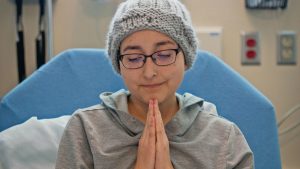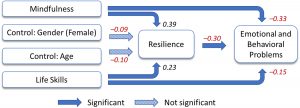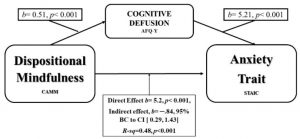Meditation Changes the Brain Differently in Adolescents
By John M. de Castro, Ph.D.
“The benefits of meditation are many with few, if any, drawbacks. If your teen is struggling, it’d be worth it to give it a try.” – Tyler Jacobson
There has accumulated a large amount of research demonstrating that mindfulness has significant benefits for psychological, physical, and spiritual wellbeing. It even improves high level thinking known as executive function. Its positive effects are so widespread that it is difficult to find any other treatment of any kind with such broad beneficial effects on everything from thinking to mood and happiness to severe mental and physical illnesses. This raises the question of how mindfulness training could produce such widespread and varied benefits. One possibility is that mindfulness practice results in beneficial changes in the nervous system.
The nervous system is a dynamic entity, constantly changing and adapting to the environment. It will change size, activity, and connectivity in response to experience. These changes in the brain are called neuroplasticity. Over the last decade neuroscience has been studying the effects of contemplative practices on the brain and has identified neuroplastic changes in widespread areas. In other words, mindfulness practice appears to mold and change the brain, producing psychological, physical, and spiritual benefits. The brains of adolescents are different from fully mature adult brains. They are dynamically growing and changing. It is unclear how mindfulness affects their maturing brains.
In today’s Research News article “Gray Matter Changes in Adolescents Participating in a Meditation Training.” (See summary below or view the full text of the study at: https://www.ncbi.nlm.nih.gov/pmc/articles/PMC7456888/ ) Yuan and colleagues recruited adolescents aged 14 to 19 years and provided them with a 12 week training in mindfulness meditation. They and a control sample of adolescents underwent Magnetic Resonance Imaging (MRI) of their brains before and after training.
They found that after training there was a significant reduction in the volume of gray matter in the left thalamus, left putamen, and left posterior insula. There was no significant influence of age on the decreased volumes. Also, there were no significant increases in gray matter volume were found anywhere in the adolescents’ brains.
These results are very surprising. In adults, mindfulness training has been repeatedly shown to increase gray matter volume, not decrease it. The insula, in particular, has been shown to increase in volume after mindfulness training in adults. The insula is thought to underlie awareness of the internal state of the body. Since, mindfulness training usually increases this awareness, the increase in insula volume makes sense, but that it would decrease in volume in the adolescents does not.
During adolescents the brain is actively growing and changing. It is possible that mindfulness training affects the growing brain differently than after maturation in adulthood. This suggests that mindfulness may have different effects in adolescents than in adults. But this has not been shown to be the case. In fact, mindfulness training appears to have the same effects in adolescents as in adults. More research is needed to further investigate this phenomenon.
So, it would appear that meditation changes the brain differently in adolescents.
“It is well-documented that mindfulness helps to relieve depression and anxiety in adults. A small but growing body of research shows that it may also improve adolescent resilience to stress through improved cognitive performance and emotional regulation.” – Malka Main
CMCS – Center for Mindfulness and Contemplative Studies
This and other Contemplative Studies posts are also available on Google+ https://plus.google.com/106784388191201299496/posts and on Twitter @MindfulResearch
Study Summary
Justin P. Yuan, Colm G. Connolly, Eva Henje, Leo P. Sugrue, Tony T. Yang, Duan Xu, Olga Tymofiyeva. Gray Matter Changes in Adolescents Participating in a Meditation Training. Front Hum Neurosci. 2020; 14: 319. Published online 2020 Aug 14. doi: 10.3389/fnhum.2020.00319
Abstract
Meditation has shown to benefit a wide range of conditions and symptoms, but the neural mechanisms underlying the practice remain unclear. Magnetic resonance imaging (MRI) studies have investigated the structural brain changes due to the practice by examining volume, density, or cortical thickness changes. However, these studies have focused on adults; meditation’s structural effects on the adolescent brain remain understudied. In this study, we investigated how meditation training affects the structure of the adolescent brain by scanning a group of 38 adolescents (16.48 ± 1.29 years) before and after participating in a 12-week meditation training. Subjects underwent Training for Awareness, Resilience, and Action (TARA), a program that mainly incorporates elements from mindfulness meditation and yoga-based practices. A subset of the adolescents also received an additional control scan 12 weeks before TARA. We conducted voxel-based morphometry (VBM) to assess gray matter volume changes pre- to post-training and during the control period. Subjects showed significant gray matter (GM) volume decreases in the left posterior insula and to a lesser extent in the left thalamus and left putamen after meditation training. There were no significant changes during the control period. Our results support previous findings that meditation affects regions associated with physical and emotional awareness. However, our results are different from previous morphometric studies in which meditation was associated with structural increases. We posit that this discrepancy may be due to the differences between the adolescent brain and the adult brain.
https://www.ncbi.nlm.nih.gov/pmc/articles/PMC7456888/









